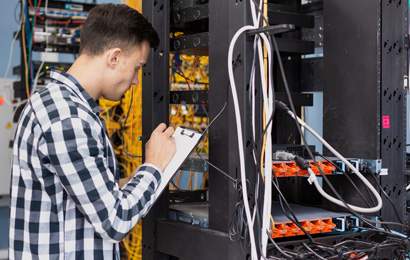- (5.0 Star)
CCIE Enterprise Infrastructure
Certification Training
We provide Classroom and Live Instructor led virtual classroom training by certified trainers/ industry professionals
- Get Up to 25% discount
About Course
The new CCIE Enterprise Infrastructure is highest level certification in Cisco networking domain that prepares you for today’s expert-level job roles in enterprise network technologies. CCIE Enterprise Infrastructure now cover the broad area of networking includes Routing, Switching, Security, SD WAN Technology, Network Management, Automation and Programmability to help you scale your enterprise infrastructure.
CCIE Enterprise Infrastructure is design based on new CCIE Certification to cover in details topic of Expert Level.
CCIE is one of the industry’s most respected certifications that will recognized your highest level networking skill and help you achieve your network technical leadership
To Learn CCIE Enterprise Infrastructure – Integrated program in Kolkata, CloudNet is first training institute to prepare you next generation IT Networking technologies with highly experienced subject expert trainer in relevant technology. Our trainer are not only certified, but also have vast experienced on real time technology solution and training domain. CCIE training in Kolkata at CloudNet will assured you get train and create project with physical Routers, Switches and Firewall appliances
COURSE KEY HIGHLIGHT:
- You will prepare based on newly designed CCIE Enterprise Infrastructure
- CCIE Enterprise Infrastructure Training in Kolkata will also come with great job opportunity
- CCIE Enterprise Infrastructure course at CloudNet, will assure you 100% quality learning experience.
- CCIE Enterprise Infrastructure Certification course in Kolkata conducted by Highly Experienced and Certified Trainer.
- Successfully completion of course you will earn a course completion certificate
- After completion of CCIE Training at CloudNet you will get 3 years dedicated placement support.
- Our CCIE Enterprise Infrastructure program come with life time eLearning and placement Support
JOB ROLES:
- Network Engineer | Network Administrator | Sr. Network Specialist | IT Manager | Network Planer | Network Architect
Key Features
You will get 100% job Assurance and life time e-placement support
classed taken by globally certified trainers
You will get 3 year Dedicated placement support
Courses are globally recognized & accredited

Course Type:
Certification Training
Live virtual classroom:
55,000 /-
70,000/-
Regular classroom:
55,000 /-
70,000/-
- Duration:
120 Hrs
- Enrolled:
110 Learners
- Eligibility:
10+2 / Graduate
- 5 Star:
15 Reviews
CCIE Enterprise Infrastructure Course Curriculum
MODULE - I
ARCHITECTURE
- Explain the different design principles used in an enterprise network
- Analyze design principles of a WLAN deployment
- Differentiate between on-premises and cloud infrastructure deployments
- Explain the working principles of the Cisco SD-WAN solution
- Explain the working principles of the Cisco SD-Access solution
- Describe concepts of wired and wireless QoS
- Differentiate hardware and software switching mechanisms
VIRTUALIZATION
- Describe device virtualization technologies
- Configure and verify data path virtualization technologies
- Describe network virtualization concepts
INFRASTRUCTURE
- Layer 2 Technology:
- Troubleshoot static and dynamic 802.1q trunking protocols
- Troubleshoot static and dynamic EtherChannels
- Configure and verify common Spanning Tree Protocols (RSTP and MST)
- Layer 3 Technology:
- Compare routing concepts of EIGRP and OSPF (advanced distance vector vs. linked state, load balancing, path selection, path operations, metrics)
- Configure and verify simple OSPF environments, including multiple normal areas, summarization, and filtering (neighbor adjacency, point-to-point and broadcast network types, and passive interface)
- Configure and verify eBGP between directly connected neighbors (best path selection algorithm and neighbor relationships)
- Wireless Technology
- Describe Layer 1 concepts, such as RF power, RSSI, SNR, interference noise,
- band and channels, and wireless client devices capabilities
- Describe AP modes and antenna types
- Describe access point discovery and join process (discovery algorithms,
- WLC selection process)
- Describe the main principles and use cases for Layer 2 and Layer 3 roaming
- Troubleshoot WLAN configuration and wireless client connectivity issues
- IP Services
- Describe Network Time Protocol (NTP)
- Configure and verify NAT/PAT
- Configure first hop redundancy protocols, such as HSRP and VRRP
- Describe multicast protocols, such as PIM and IGMP v2/v3
NETWORK ASSURANCE
- Diagnose network problems using tools such as debugs, conditional debugs, trace route, ping, SNMP, and syslog
- Configure and verify device monitoring using syslog for remote logging 2019
- Cisco Systems, Inc. This document is Cisco Public. Page 3
- Configure and verify NetFlow and Flexible NetFlow
- Configure and verify SPAN/RSPAN/ERSPAN
- Configure and verify IPSLA
- Describe Cisco DNA Center workflows to apply network configuration, monitoring, and management
- Configure and verify NETCONF and RESTCONF
SECURITY
- Configure and verify device access control
- Configure and verify infrastructure security features
- Describe REST API security
- Configure and verify wireless security features
- Describe the components of network security design
AUTOMATION
- Interpret basic Python components and scripts
- Construct valid JSON encoded file
- Describe the high-level principles and benefits of a data modeling language, such as YANG
- Describe APIs for Cisco DNA Center and vManage
- Interpret REST API response codes and results in payload using Cisco DNA
- Center and RESTCONF
- Construct EEM applet to automate configuration, troubleshooting, or data collection
- Compare agent vs. agentless orchestration tools, such as Chef, Puppet,
- Ansible, and SaltStack
NETWORK INFRASTRUCTURE
Switched campus
- Switch administration
- Layer 2 protocols
- LAN technologies
- Spanning-Tree
Routing Concepts
- Administrative distance
- VRF-lite
- Static routing
- Policy-based routing
- VRF aware routing with any routing protocol
- Filtering with any routing protocol
- Manual summarization with any routing protocol
- Redistribution between any pair of routing protocols
- Routing protocol authentication
- Bidirectional Forwarding Detection
EIGRP
- Adjacencies
- Best path selection
- Operations
- EIGRP load-balancing
- EIGRP named mode
- Optimization, convergence and scalability
OSPF (v2 and v3)
- Adjacencies
- Network types, area types
- Path preference
- Operations
- Optimization, convergence and scalability
BGP
- IBGP and EBGP peer relationships
- Path selection
- Routing policies
- AS path manipulations
- Convergence and scalability
- Other BGP features
Multicast
- Layer 2 multicast
- Reverse path forwarding check
- PIM
SOFTWARE DEFINED INFRASTRUCTURE
Cisco SD Access
- Design a Cisco SD Access solution
- Cisco SD Access deployment
- Segmentation
- Assurance
Cisco SD-WAN
- Design a Cisco SD-WAN solution
- WAN edge deployment
- Configuration templates
- Localized policies (only QoS)
- Centralized policies
TRANSPORT TECHNOLOGIES AND SOLUTIONS
MPLS
- Operations
- L3VPN
DMVPN
- Troubleshoot DMVPN phase 3 with dual-hub
- Identify use-cases for FlexVPN
INFRASTRUCTURE SECURITY AND SERVICES
Device Security on Cisco IOS XE
- Control plane policing and protection
- AAA
Network Security
- Switch security features
- Router security features
- IPv6 First Hop Security features
- IEEE 802.1X Port-Based Authentication
System Management
- Device management
- SNMP
- Logging
Quality of Service
- End to end L3 QoS using MQC
Network Services
- First-Hop Redundancy protocols
- Network Time Protocol
- DHCP on Cisco IOS
- IPv4 Network Address Translation
Network optimization
- IP SLA
- Tracking object
- Flexible netflow
Network operations
- Traffic capture
- Cisco IOS-XE Troubleshooting tools
INFRASTRUCTURE AUTOMATION AND PROGRAMMABILITY
Data encoding formats
- JSON
- XML
Automation and scripting
- EEM applets
- Guest shell
Programmability
- Interaction with vManage API
- Interaction with Cisco DNA Center API
- Interaction with Cisco IOS XE API
- Deploy and verify model-driven telemetry
Sent Us a Message

